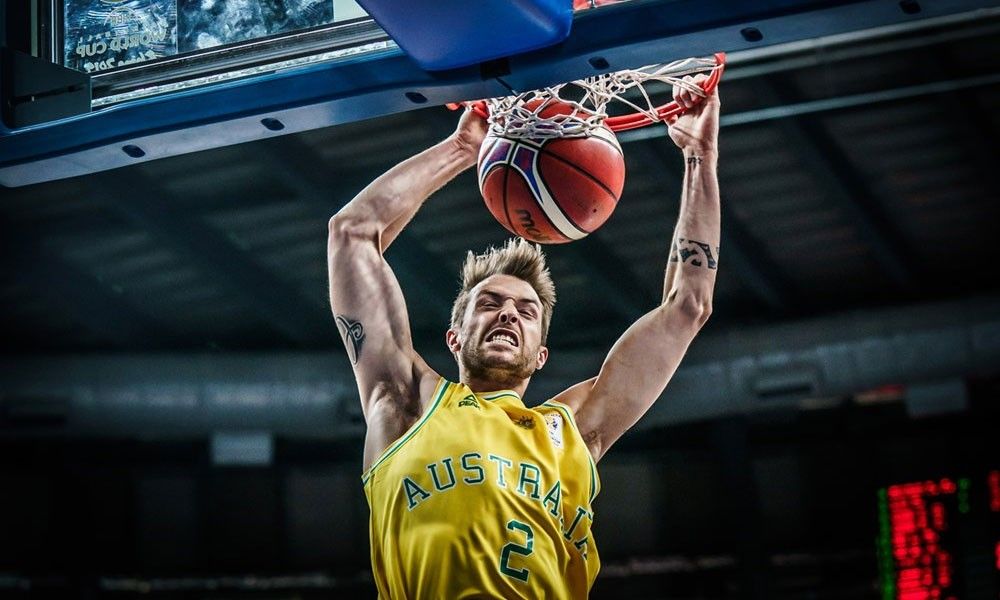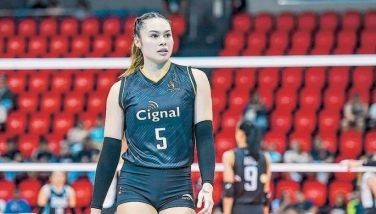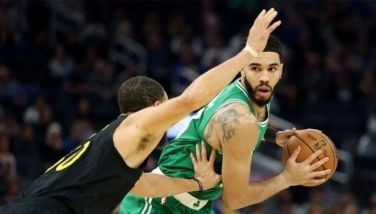Boomers' deep talent reservoir is Gilas' brick wall

First-time national player Nathan Sobey slams it home in the Aussies' win over Chinese-Taipei last November to open its 2019 FIBA World Cup campaign.
(Editor's note: This article was originally published on February 20, 2018 on thefilipinoconnection.net and is used with permission from the website.)
ADELAIDE, Australia — Talent inequality is Asian basketball’s new normal. World no. 10 Australia subtly gives that message through modesty, backed up by efficient play.
Humility by Aussie hoopsters prevails in a country where basketball is not even a top five sport in terms of fan euphoria. Not even the splendid all-around play of current NBA rookie Ben Simmons of the Philadelphia 76ers can stir his compatriots’ hoop interest.
Not even seven other Australian cagers who are now in the world’s best league. Not even after Australia ruled the 2017 FIBA Asia Cup in Lebanon.
Fervor toward Australian Rules Football or “Footy” (localized rugby), international rugby, cricket, international football, motorsports, horse racing and tennis swats away the “oomph” that other nations crave for in game-winning triples and slam dunks.
Setting aside cultural differences toward basketball, Australia is the modern-day seedbed of Asian basketball. The reservoir of skilled players — playing in the NBA, the country’s National Basketball League and in European leagues — may be as wide as the country’s 7.7 million sq. km. land area.
A portion of that Australian hoop talent well faces some of the best from the Philippines and its “Gilas” squad. A portion of that hoop talent, sans NBA players, ruled Lebanon.
“In the Asia Cup,” Boomers coach Andrej Lemanis said last November 26 at the Titanium Security Arena in Findon suburb, “not everyone had their main squads… We really respect the Asian teams. Whenever teams play hard there’s always competition.”

But Lemanis knows the Filipinos. At a 2014 pocket tournament in Antibes, France prior to that year’s FIBA World Cup, the Boomers had five NBA players, and Gilas managed a 68-all tie after three quarters. But a 15-5 fourth quarter blast by the Boomers bombed the Filipinos’ hopes, leading to a 97-75 thrashing.
The echoes of three years’ past still ring to Lemanis. “They (Filipinos) are very, very good — a good athletic group. They move the ball, let them fly, play with good energy and fun around them.”
“We want these good games and it’s fun,” Lemanis added after the Boomers whipped Japan’s Akatsuki five, 82-58, in Findon. “These games help build the team (Boomers).”
Thursday will see two cultural hoops traditions displaying their contrasts. Aussie and Filipino fans alone can feel who’s more energetic, crazier at cheering.
It will be deliberate half-court sets by the taller Boomers versus the “streetball-like,” unorthodox playing style of the smaller Filipinos, with the latter having a hangover to the dribble-drive offense.
Australia’s mobile second-level centers Daniel Kickert and Matthew Hodgson have been dominating the paint over Asian teams in Lebanon and in the early Asian qualifying matches. But the wingmen reveal the Aussies’ versatility: Mitch Creek, Jason Cadee, Nicholas Kay, and former Rio Olympian and two-time NBL MVP Kevin Lisch.
The guard spot, Jason William’s terrain, is obviously the Filipinos’ strong spot. What more if Terrence Romeo wasn’t injured?
“That guy Romeo?” said Akatsuki guard Yuri Togashi who got banged up by taller Boomer defenders during Japan’s loss. “If he comes back, they (Australians) can’t stop him. The Filipinos will have a chance.”
Filipino-brand basketball, though inexperienced in world play, surprised top-level teams at the 2014 FIBA World Cup in Spain, with Gilas almost upsetting higher-ranked Croatia, Argentina and Puerto Rico. The game against the Philippines “was the most uncomfortable game for me,” said then Argentinean coach Julio Llamas, now handling Japan.
However, the Filipinos aren’t exactly known for defense. They also have the penchant for squandering double-digit leads — versus France, Puerto Rico and Argentina for example — and wither in the end, leaving Pinoy fans muff “what a pity” (sayang!).
Nevertheless, Filipino play in Asia had grown leaps and bounds unlike 15 years ago when even Filipino basketball leaders argued over power and nearly dragged the national program into a black hole globally.
As for Australia, the trajectory is upwards. After decades of ruling the Oceania zone over the New Zealand Tall Blacks, the Boomers frequent the quadrennial World Cups and Olympic Games. The country’s FIBA legends and a former NBA champion had retired, not until a new crop sustained the talent well.
Now with Simmons, surprisingly left out in the 2016 Rio Olympics squad that narrowly missed a bronze medal against Spain, the immediate goal is Tokyo 2020. Simmons told reporters of the Australian Broadcasting Corp. after an NBA game at home, “One of my goals is to win a medal with Australia and I want a gold medal.”
“There’s a lot of Aussies in the NBA now, it’s really fun,” says the current leading candidate for NBA Rookie of the Year.
The 2019 FIBA World Cup in China, where seven slots are at stake for Asia, is mere training ground for the Boomers’ trajectory, which is Tokyo 2020. Even as Lemanis chuckles modesty at the Asian teams, the tougher competition is not in Asia.
The Philippines, now 31st worldwide, also has a medium-term vision: perform well at the 2023 FIBA World Cup where the country will be the lead co-host together with Japan and possibly Indonesia.
A surprising win over Australia this Thursday may be a big deal for Philippine basketball, and an embarrassment for a second-rate Australian team at home. The mountain to climb? The depth of the Boomers’ talent well in basketball.
After the 82-58 win over Japan in Findon (just outside of Adelaide), Lemanis said: “We have an ability to play all 12 players to maintain at a level of 40 minutes. That is difficult for other teams to play against unless they have a similar depth.” — Jeremaiah Opiniano
- Latest
- Trending





























